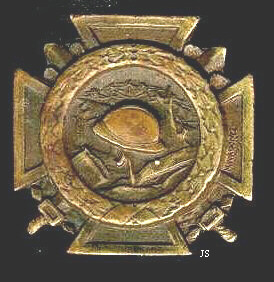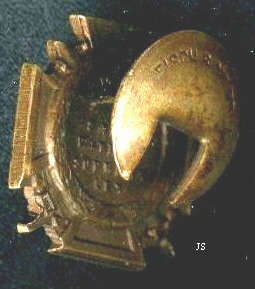

The Fire Cross 1914-1918
Awarded to all that shortly after the war received the so called "Fire Card", i.e. all who came under fire at the front. Holders of this card also received a plaque in either French or Flemish, according to their mother tongue. |
 |
 |
 |
The decoration is a bronze cross with short, broad arms was instituted on 6 February 1934 and is worn immediately after the Yser Medal (or Cross). It could not be awarded posthumously. The obverse depicts in the large rectangular panel, flanked by a vertical laurel twig on either side, an abandoned battlefield : a helmet on top of a bajonet in front, a hill with a 75mm field gun at the back, with the sun shining through some clouds. The reverse has in the panel a royal crown with seven rays emanating from it, a large oak leaf branch with a latin text across : "SALUS PATRIAE / SUPREMA LEX" and the years "1914 / 1918" in the lower right corner. In the lower left corner is the designer's name : A. Rombaut. The ribbon is red with light blue edges and a light blue centre stripe. Three types of this medal exist with several differences (all relative to the producing manufacturer) for models 1 and 2. The 3rd model can best be described as a smaller and narrower type 2. |
First Model |
|
 |
 |
Second Model |
|
All three types' obverses |
All three types, reverses |
There is also a buttonhole badge which is related to this medal and was in fact properly and officially instituted on 27 April 1933, prior to the medal. It was conferred on the same holders of the "Fire Card". The reverse reads "1914-1918 / Salus / Patriae / Suprema / Lex" as on the later medal's reverse. |
 |
 |
Above enlargements courtesy of Mr. Joseph Shannon

The top two lapel badges are the official types (variations per manufacturer can be encountered) and show the actual size. The middle badges are smaller sized ones and do not have the reverse text. The high esteem in which veterans held this decoration can be seen by the fact that even cufflinks were made (bottom of picture) and a reproduction of the cross can be found on gravestones (see picture below, the actual plate is about twice larger). |

Copyright Hendrik Meersschaert 2024 ©